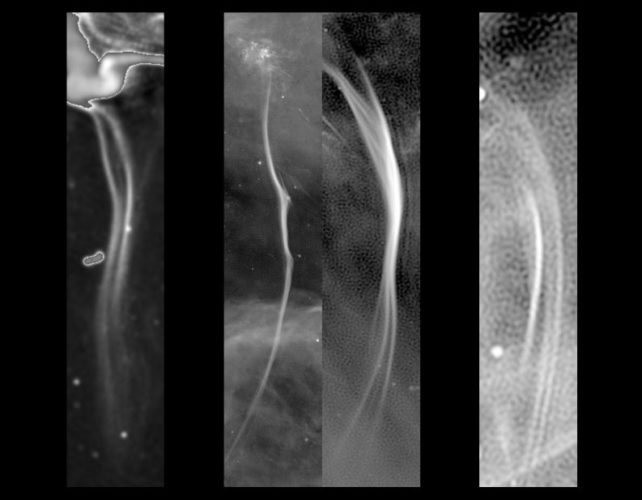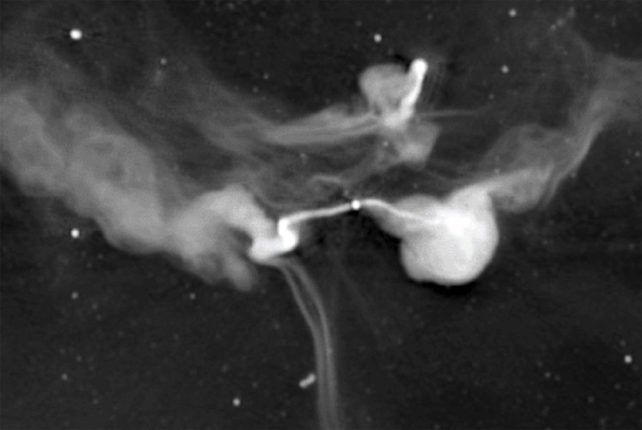We're getting closer to resolving the strange mystery presented by hundreds of enormous filaments dangling through the heart of the Milky Way.
For the first time, these long, magnetized filaments glowing in radio waves have been observed emerging from other galaxies. Not only are they no longer unique to the Milky Way, the range of environments in which they can be found is allowing scientists to narrow down the mechanisms that create them.
Astrophysicist Farhad Yusuf-Zadeh of Northwestern University in the US first discovered the Milky Way's filaments in the 1980s, and has been puzzling over them ever since.
According to Yusuf-Zadeh, there are two possible explanations. The first is an interaction between galactic winds and large clouds; the second is turbulence within weak magnetic fields stirred by the motion of galaxies.
"We know a lot about the filaments in our own Galactic Center, and now filaments in outside galaxies are beginning to show up as a new population of extragalactic filaments," Yusuf-Zadeh says.
"The underlying physical mechanisms for both populations of filaments are similar despite the vastly different environments. The objects are part of the same family, but the filaments outside the Milky Way are older, distant cousins – and I mean very distant (in time and space) cousins."
Around 1,000 of the filaments, measuring up to 150 light-years in length and hanging in strangely neat and orderly arrangements like harp strings, have been discovered in the Milky Way to date, most recently thanks to the MeerKAT radio telescope in South Africa.
The telescope's sensitive observations of the galactic center – penetrating through the thick dust and gas that obscures much of what's inside – expanded the number of filaments known previously by a factor of ten. These radio observations also revealed that the filaments contain cosmic ray electrons spinning around in magnetic fields at close to the speed of light, and that magnetic fields are amplified along the entire length of all the filaments.

Without more information, figuring out why they're there, just quietly hanging out in the galactic center, was going to be tricky. The discovery of more filaments, in four different galaxy clusters ranging between 163 million and 652 million light-years away, is a huge breakthrough.
"After studying filaments in our own Galactic Center for all these years, I was extremely excited to see these tremendously beautiful structures," Yusuf-Zadeh says. "Because we found these filaments elsewhere in the Universe, it hints that something universal is happening."
The newly discovered filaments outside of the Milky Way are different from our galaxy's thread-like structures in several pretty important ways. They're associated with jets and lobes of radio galaxies – huge structures that erupt from the galactic center, extending vast distances on either side of the galactic plane. The filaments that extend from these jets and lobes are also far larger than the structures seen in the Milky Way's center – between 100 and 1,000 times larger.
"Some of them have amazing length, up to 200 kiloparsecs," Yusuf-Zadeh says.
"That is about four or five times bigger than the size of our entire Milky Way. What's remarkable is that their electrons stay together on such a long scale. If an electron traveled at the speed of light along the filament's length, it would take it 700,000 years. And they don't travel at the speed of light."

They're also older, and their magnetic fields are weaker. And, of course, they extend out into intergalactic space, often at right-angles to the jets. The Milky Way's filaments appear to be centered on the galactic disk.
On the other hand, the similarities are strong. The galactic and extragalactic filaments have the same length-to-width ratio, and the cosmic ray transport mechanism is the same. If the same mechanism produces all the filaments, it needs to be something that works on different scales.
Winds could be one such mechanism. Active supermassive black holes and rampant star formation can generate galactic winds that gust out into intergalactic space. These winds could push into the tenuous clouds of gas and dust that drift through interstellar and intergalactic space, pushing the material together to create filamentary structures.
Simulations suggested another possibility: turbulence in the medium, generated by gravitational disturbances. This turbulence can create eddies in the intergalactic medium, around which weak magnetic fields get snagged, folded, and ultimately stretched out into filaments with strong magnetic fields.
It's not a definitive answer – yet. We don't even know for sure if the same mechanism is responsible for both kinds of filaments, or if vastly different phenomena create structures that look uncannily alike.
"All of these filaments outside our galaxy are very old," Yusuf-Zadeh says.
"They are almost from a different era of our Universe and yet signaling the Milky Way inhabitants that a common origin exists for the formation of the filaments. I think this is remarkable."
The research has been published in The Astrophysical Journal Letters.
